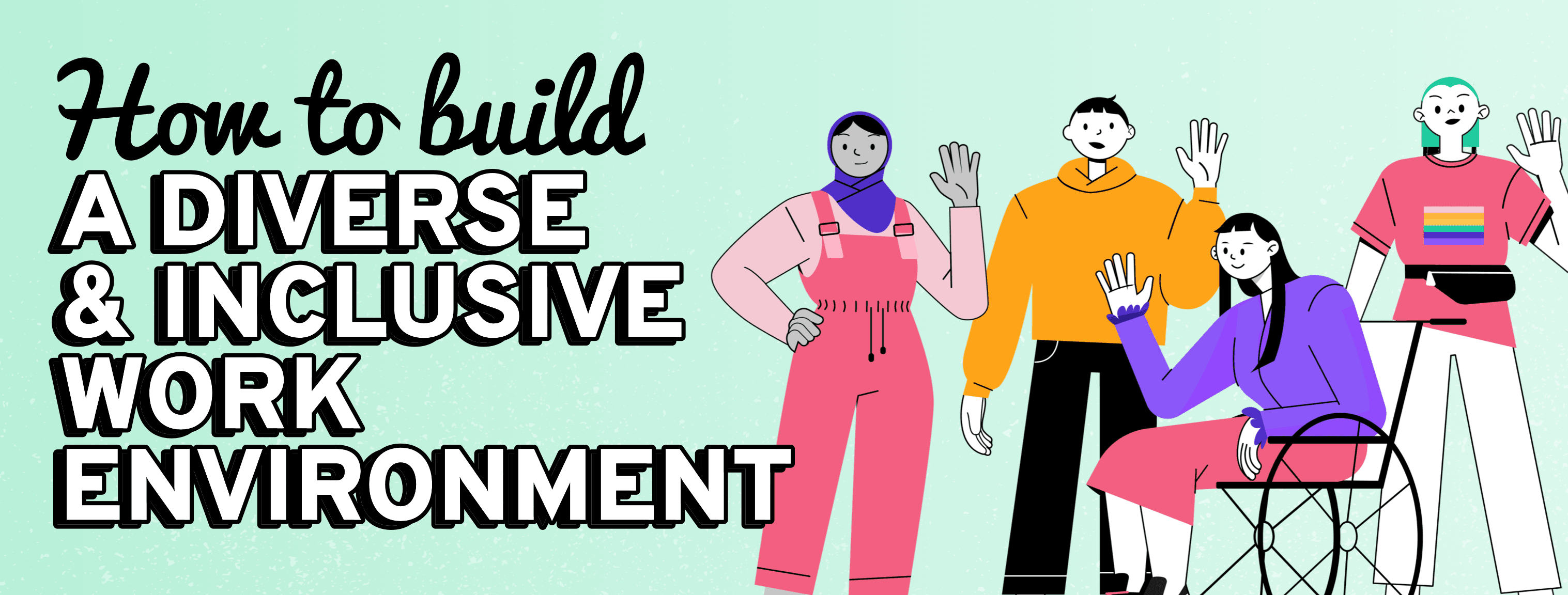How To Build A Diverse And Inclusive Work Environment
3rd Jul 2023

Building a diverse and inclusive work environment is not only a matter of social importance but also a strategic way to accelerate company growth.
Companies that are inclusive can unlock a number of benefits such as driving innovation, increasing productivity, and strengthening employee morale. Recognising the unique needs of individuals and embracing their diverse characteristics and responsibilities is essential for cultivating a progressive workplace where every person can thrive.
And with a staggering 86% of candidates considering diversity and inclusion as a critical factor, it means companies that prioritise these values are better positioned in attracting and retaining a diverse pool of talent.
Now let’s go through some of the key ways you can build a diverse and inclusive workplace.
Build diversity and inclusion into your mission
Building a diverse and inclusive company culture goes beyond the hiring process; it's integral to your company's DNA. It needs to be embodied by your core values where equality, respect, and openness are prioritised. This commitment to diversity and inclusion also contributes to your Employer Brand, where you can demonstrate these commitments and attrac candidates who align with your values. And through consistently communicating your dedication to diversity and inclusion you enhance your company's reputation as an equitable employer of choice.
Implement diverse hiring practices
Creating an inclusive hiring process is an ongoing effort where you’ll need to assess the effectiveness of your strategies and seek feedback to improve. Strategies to create an inclusive process include blind CV screenings, diverse interview panels and could also include the use of an Employer Brand platform such as Flexa to source and attract candidates from a wide range of backgrounds both fairly and equitably - pending you pass the initial Flexification process – which in itself sets you apart and is trusted by candidates
Promote a culture of inclusion
Leadership plays a crucial role in setting the tone for inclusivity, it's about having a clear commitment to diversity and inclusion that is role modelled from the top down. Leaders should consistently communicate the importance of diversity, model inclusive behaviours, and hold themselves accountable for creating an inclusive culture. This includes:
- Inclusive decision-making - involve a diverse range of voices in decision-making processes and seek input from employees at all levels to ensure that diverse perspectives are considered.
- Inclusive communication - use inclusive language and avoid assumptions based on gender, ethnicity, or other characteristics. And make sure communication channels and practices are inclusive and accessible to all employees.
- Address biases - create a zero-tolerance policy for microaggressions, discrimination, and biases and establish clear procedures to address and resolve issues promptly and fairly. It can help to train your team on this.
- Recognise and celebrate differences - create opportunities to celebrate and recognise diversity within your teams through cultural holidays, heritage months, or diversity-focused events. and encourage your employees to share their unique experiences and traditions.
Offer flexible working arrangements
Everyone has unique needs, preferences, and responsibilities. Whether it’s disabilities, health conditions, childcare obligations, or caring responsibilities for family members, it’s important to provide a range of flexible working arrangements. Flexibility should not be limited or an opt-in process, it should be made available to all, acknowledging that a one-size-fits-all approach is ineffective.
Embracing different types of flexibility, such as fully remote, remote-first, hybrid, compressed hours or job-sharing opportunities, can greatly benefit individuals with diverse circumstances. But it’s essential to ensure that all employees have equal access to these options and that they are implemented fairly and consistently throughout your company.
Doing so sends a powerful message that inclusivity is valued, making your company more appealing to individuals who prioritise work-life balance or need the flexibility to accommodate their specific circumstances.
Offer equal opportunities for development
One effective strategy for providing equal opportunities for development is through mentorship programs. These programs pair employees from underrepresented groups with more experienced mentors who can provide guidance, support, and valuable insights to support learning and development.
Mentors can offer advice on career advancement, share their experiences, and help mentees develop the critical skills and knowledge necessary to progress. Connecting individuals from diverse backgrounds with mentors also facilitates networking, increases visibility, and opens doors to new opportunities that might otherwise be inaccessible.
Address pay equity
To begin addressing pay equity, it is essential to carry out thorough pay audits. This involves collecting and analysing data on employee compensation, including factors such as job level, experience, and performance, while also considering gender, race, and other aspects of diversity. The purpose of these audits is to identify any disparities or gaps in pay that may be influenced by factors unrelated to job-related qualifications or performance.
Once potential pay gaps are identified, companies should take the necessary steps to rectify disparities. This may involve adjusting salaries, implementing transparent and consistent compensation structures, and establishing clear guidelines for pay decisions. It is crucial to ensure that pay decisions are based on objective criteria, such as job responsibilities, skills, experience, and performance, rather than influenced by unconscious biases or discriminatory practices.
Investing efforts in building an inclusive work environment is not only an ethical and social imperative, but it's also required for long-term success. And a workplace culture where every individual feels valued and respected leads to improved innovation, and problem-solving. It promotes employee satisfaction, collaboration, and teamwork, which in turn boosts productivity and drives growth.
Investing in diversity and inclusion is not just a moral obligation; it is a strategic choice that yields significant benefits for individuals, companies, and society as a whole.